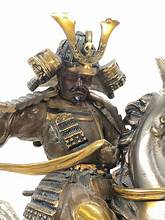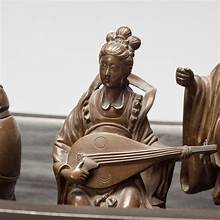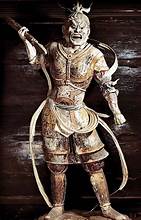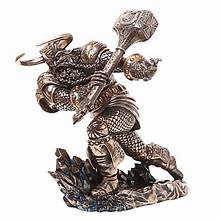Ikoku with Hammer Japanese Bronze Sculpture: A Masterpiece of Craftsmanship and Culture

The art of sculpture has long been one of the most revered forms of human expression, particularly in cultures that have rich histories and artistic traditions. Among the many kinds of sculptures that have emerged across the globe, Ikoku with Hammer Japanese Bronze Sculpture stands out as a unique and highly admired piece of craftsmanship. This sculpture not only embodies the technical skill and artistry of its creators but also reflects the deep cultural significance of Japanese art.
Table of Contents
Introduction to Ikoku with Hammer Japanese Bronze Sculpture
The term Ikoku with Hammer Japanese Bronze Sculpture might sound unfamiliar to some, but it refers to a specific style of bronze sculpture that has deep roots in Japanese history. The word “Ikoku” is a term that describes foreign influences or materials that have been integrated into Japanese traditions, often bringing with them new techniques and ideas. In this case, the sculpture is crafted from bronze, a metal that has been used by civilizations around the world for centuries. The hammering technique involved in shaping the bronze adds a distinct texture and personality to the sculpture, marking it as a special form of Japanese artistry.
This unique blend of cultural influence and craftsmanship results in a Ikoku with Hammer Japanese Bronze Sculpture that stands as both an object of beauty and a testament to the skill of its creators. These sculptures often tell stories, represent deities, or serve as symbols of power and status in the community. In this article, we will explore the history, techniques, significance, and allure of Ikoku with Hammer Japanese Bronze Sculpture.
Historical Background of Ikoku with Hammer Japanese Bronze Sculpture

The origins of bronze casting in Japan can be traced back to the 6th century, during the introduction of Buddhism from Korea and China. The use of bronze in religious iconography quickly became widespread, and the Japanese began to refine their casting techniques. The Ikoku with Hammer Japanese Bronze Sculpture style, however, incorporates foreign influences, especially from China and Korea, into traditional Japanese craftsmanship.
One of the most important periods in the development of Japanese bronze sculpture was during the Nara (710-794) and Heian (794-1185) periods. This was when the Japanese saw a fusion of foreign artistic traditions, particularly in the form of Buddhist sculptures and ceremonial items. During these times, Japanese artists began experimenting with new methods of bronze casting and techniques, often creating sculptures with intricate detailing, hammering, and finishing techniques that set them apart from their continental counterparts.
As Japan’s artistic heritage evolved, so too did its approach to the Ikoku with Hammer Japanese Bronze Sculpture. The fusion of imported techniques with native Japanese design created a unique genre that was both innovative and deeply symbolic, making it highly prized among collectors, art historians, and enthusiasts alike.
The Crafting Process of Ikoku with Hammer Japanese Bronze Sculpture
Crafting a Ikoku with Hammer Japanese Bronze Sculpture requires precision, patience, and a deep understanding of both the materials and techniques used. Bronze, an alloy of copper and tin, is a perfect material for sculpture due to its durability, workability, and rich patina. However, it is also a challenging medium to master, requiring significant expertise to create the intricate designs and shapes that define these sculptures.
The process begins with the creation of a model or design, often based on religious, mythological, or cultural themes. The sculptor will then create a mold, traditionally from clay or wax, in which the molten bronze is poured. Once the basic form has cooled and solidified, the true artistry begins. This is where the hammering technique comes into play. Using specialized tools, the artist will delicately shape the surface of the sculpture by hand, tapping and refining the contours to add texture and depth. This step is crucial to achieving the unique appearance of the Ikoku with Hammer Japanese Bronze Sculpture, as it ensures that the work not only embodies the theme it represents but also exhibits the delicate craftsmanship that is characteristic of Japanese art.
In some cases, the sculpture may be further enhanced by applying gold leaf, intricate engravings, or colored patinas. These additional layers of artistry elevate the sculpture, making it a multi-dimensional work of art that is both visually striking and culturally significant.
Cultural Significance of Ikoku with Hammer Japanese Bronze Sculpture

Every Ikoku with Hammer Japanese Bronze Sculpture tells a story, whether it’s a representation of a deity, an iconic figure, or a symbol of cultural heritage. The intricate details and the hammering technique give the sculpture not only its visual appeal but also an aura of depth and history. These works are not simply decorative; they are imbued with meaning and serve as a powerful connection to the past.
In many cases, these bronze sculptures were commissioned by religious institutions or high-ranking members of society. They were intended to invoke spiritual blessings, commemorate significant events, or assert the social status of the patron. The Ikoku with Hammer Japanese Bronze Sculpture could serve as an object of devotion, an offering to the gods, or even a ceremonial object used during rituals.
Additionally, these sculptures were often crafted for use in Buddhist temples or Shinto shrines. As Japan’s two predominant religious practices, Buddhism and Shintoism, were often the driving forces behind artistic creation, the themes of Ikoku with Hammer Japanese Bronze Sculpture reflected the spiritual beliefs and practices of the time. For example, a bronze sculpture depicting a Buddhist deity would have been created to inspire reverence and devotion in worshippers, while a Shinto shrine sculpture might be intended to convey the presence of a kami, or divine spirit, in the physical world.
Through these sculptures, the Japanese people were able to express their connection to the divine and to their cultural identity, as well as their reverence for the natural world. The craftsmanship behind Ikoku with Hammer Japanese Bronze Sculpture elevated it to a sacred object, reflecting the harmonious relationship between art, religion, and society.
The Aesthetic Appeal of Ikoku with Hammer Japanese Bronze Sculpture
One of the most striking aspects of Ikoku with Hammer Japanese Bronze Sculpture is its aesthetic beauty. The hammering process, which leaves small dents and marks on the surface of the bronze, creates a texture that is both raw and refined, adding a tactile quality to the sculpture. The patina that forms on the bronze over time, due to the oxidation of the metal, also contributes to the sculpture’s beauty, as it develops a rich, aged appearance that enhances its historical value.
The use of color in these sculptures is another key feature. While many Ikoku with Hammer Japanese Bronze Sculptures retain the natural golden or brown hues of the metal, others are treated with additional finishes, such as black lacquer or gold leaf, to further enhance their visual appeal. These elements can bring an added dimension to the work, making it not only an object to admire but a sensory experience that engages the viewer on multiple levels.
The design and form of Ikoku with Hammer Japanese Bronze Sculpture are also incredibly important. Whether the sculpture depicts a figure, an animal, or a religious symbol, the artist strives to achieve balance, harmony, and elegance. The proportions and details of the sculpture are carefully considered, with every line and curve meant to convey a sense of grace and movement.
The Legacy of Ikoku with Hammer Japanese Bronze Sculpture
While the creation of Ikoku with Hammer Japanese Bronze Sculpture has declined over the years, the legacy of this art form continues to inspire contemporary artists and collectors. Today, collectors highly prize these sculptures, seeking them out for their rarity and historical significance. Museums and galleries around the world showcase these works, preserving their cultural and artistic heritage for future generations.
Furthermore, the techniques used in creating Ikoku with Hammer Japanese Bronze Sculpture are still studied by artists and students of sculpture. The fusion of foreign influences with native Japanese craftsmanship serves as an important reminder of the fluid nature of artistic traditions and the ways in which cultures borrow and adapt to create something entirely new.
Also read Ruchi Gautam Manager Macquarie: Career, Leadership, and Impact
Conclusion
In conclusion, the Ikoku with Hammer Japanese Bronze Sculpture represents a fascinating fusion of craftsmanship, cultural influence, and spiritual expression. These sculptures serve as both works of art and symbols of the deep-rooted traditions of Japan. With their intricate design, hammering technique, and cultural significance, they continue to captivate audiences and remain an essential part of Japan’s artistic legacy.
Whether you are an art enthusiast, a collector, or someone with an appreciation for Japanese culture, the Ikoku with Hammer Japanese Bronze Sculpture is a remarkable example of human creativity and ingenuity. Its story, technique, and beauty continue to resonate, offering a timeless connection to Japan’s rich artistic history.




